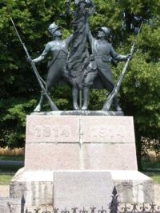
Battle of Craonne
Encyclopedia
The Battle of Craonne was fought on March 7, 1814, and resulted in a French
victory under Napoleon I
against Russians
and Prussians
under General Blücher
.
Craonne
is a village on the Chemin des Dames
, in the département of Aisne
.
Marshal Blücher had recovered from his earlier setbacks more quickly than Napoleon Bonaparte had hoped, and so the French Emperor was forced to switch his attacks from the Austrian Field Marshal Schwarzenberg
back to the Prussian commander.
Moving with speed and aggression, the French pushed the Allies over the Aisne river and while Blücher planned his counter with some 85,000 men, Napoleon's 37,000 troops struck. Napoleon's aim was to pin the Allies and then launch Marshal Ney
, leading a mixed force heavily weighted towards cavalry, in a flanking move. Unfortunately for the French, the coordination was poorly timed. Consequently Ney not only suffered heavy casualties, including cavalry commander Etienne de Nansouty
, but the Allies managed to extricate themselves from a sticky situation. Craonne cost Blucher 5,000 casualties, while Napoleon lost some 5,400.
The young French conscripted soldiers were called "Marie-Louise" (after Napoleon's second wife
) because many were too young to have a beard.
France
The French Republic , The French Republic , The French Republic , (commonly known as France , is a unitary semi-presidential republic in Western Europe with several overseas territories and islands located on other continents and in the Indian, Pacific, and Atlantic oceans. Metropolitan France...
victory under Napoleon I
Napoleon I of France
Napoleon Bonaparte was a French military and political leader during the latter stages of the French Revolution.As Napoleon I, he was Emperor of the French from 1804 to 1815...
against Russians
Russian Empire
The Russian Empire was a state that existed from 1721 until the Russian Revolution of 1917. It was the successor to the Tsardom of Russia and the predecessor of the Soviet Union...
and Prussians
Kingdom of Prussia
The Kingdom of Prussia was a German kingdom from 1701 to 1918. Until the defeat of Germany in World War I, it comprised almost two-thirds of the area of the German Empire...
under General Blücher
Gebhard Leberecht von Blücher
Gebhard Leberecht von Blücher, Fürst von Wahlstatt , Graf , later elevated to Fürst von Wahlstatt, was a Prussian Generalfeldmarschall who led his army against Napoleon I at the Battle of the Nations at Leipzig in 1813 and at the Battle of Waterloo in 1815 with the Duke of Wellington.He is...
.
Craonne
Craonne
Craonne is a commune in the Aisne department in Picardy in northern France.-History:It was the site of the Napoleonic Battle of Craonne in 1814. The former town was totally destroyed by artillery in World War I and is now an arboretum; today's town was rebuilt in the 1920s.-References:*...
is a village on the Chemin des Dames
Chemin des Dames
In France, the Chemin des Dames is part of the D18 and runs east and west in the département of Aisne, between in the west, the Route Nationale 2, and in the east, the D1044 at Corbeny. It is some thirty kilometres long and runs along a ridge between the valleys of the rivers Aisne and Ailette...
, in the département of Aisne
Aisne
Aisne is a department in the northern part of France named after the Aisne River.- History :Aisne is one of the original 83 departments created during the French Revolution on 4 March 1790. It was created from parts of the former provinces of Île-de-France, Picardie, and Champagne.Most of the old...
.
Marshal Blücher had recovered from his earlier setbacks more quickly than Napoleon Bonaparte had hoped, and so the French Emperor was forced to switch his attacks from the Austrian Field Marshal Schwarzenberg
Karl Philipp, Prince of Schwarzenberg
Karl Philipp Fürst zu Schwarzenberg Karl Philipp Fürst zu Schwarzenberg Karl Philipp Fürst zu Schwarzenberg (or Charles Philip, Prince of Schwarzenberg (April 18, 1771 – October 15, 1820) was an Austrian field marshal.- Life :...
back to the Prussian commander.
Moving with speed and aggression, the French pushed the Allies over the Aisne river and while Blücher planned his counter with some 85,000 men, Napoleon's 37,000 troops struck. Napoleon's aim was to pin the Allies and then launch Marshal Ney
Michel Ney
Michel Ney , 1st Duc d'Elchingen, 1st Prince de la Moskowa was a French soldier and military commander during the French Revolutionary Wars and the Napoleonic Wars. He was one of the original 18 Marshals of France created by Napoleon I...
, leading a mixed force heavily weighted towards cavalry, in a flanking move. Unfortunately for the French, the coordination was poorly timed. Consequently Ney not only suffered heavy casualties, including cavalry commander Etienne de Nansouty
Étienne Marie Antoine Champion de Nansouty
Count Étienne-Marie-Antoine-Champion de Nansouty was a French cavalry commander during the French Revolutionary Wars who rose to the rank of General of Division in 1803 and subsequently held important military commands during the Napoleonic Wars. Of noble Burgundian descent, he was a student at...
, but the Allies managed to extricate themselves from a sticky situation. Craonne cost Blucher 5,000 casualties, while Napoleon lost some 5,400.
The young French conscripted soldiers were called "Marie-Louise" (after Napoleon's second wife
Marie Louise, Duchess of Parma
Marie Louise of Austria was the second wife of Napoleon I, Emperor of the French and later Duchess of Parma...
) because many were too young to have a beard.

